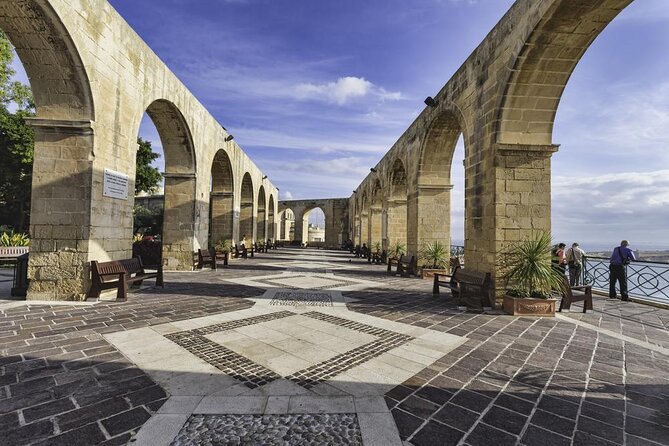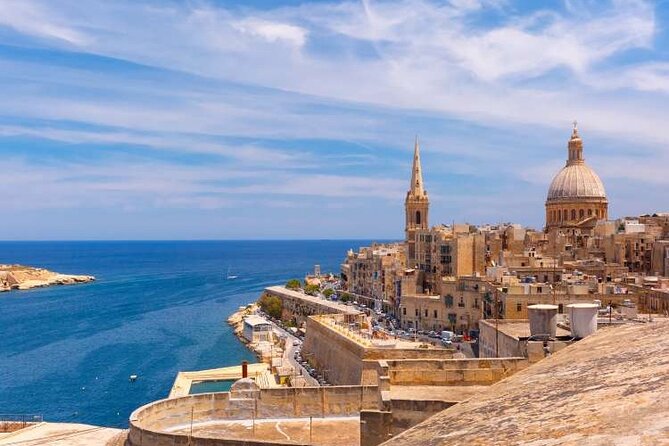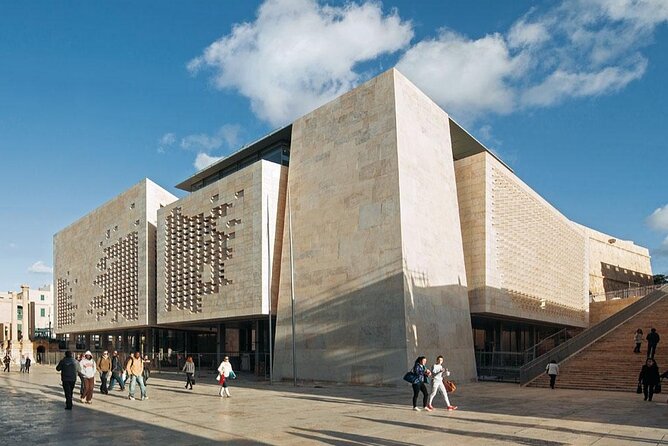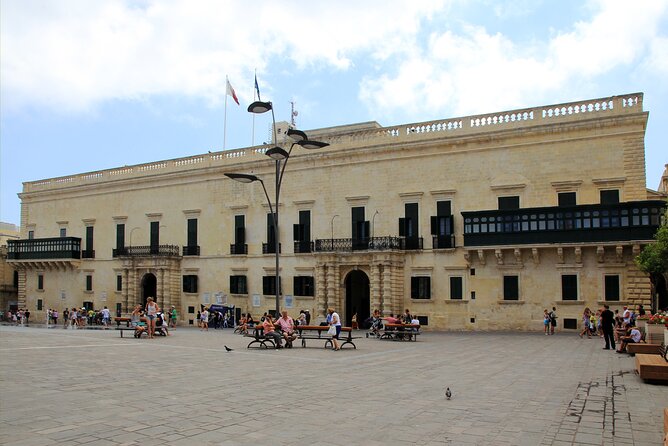Valletta’s captivating history is a tapestry of diverse cultural influences, from the architectural legacy of the Knights of St. John to the interwoven stories of slaves and mistresses. This walking tour invites you to explore the city’s remarkable past, uncovering the profound impact of Arab, Italian, and British colonial rule on Malta’s development. As you follow the path through the city’s grand palaces and imposing fortifications, you’ll be transported to a time when the island’s fate was shaped by the intricate relationships between its rulers and the people they governed. What secrets lie hidden within Valletta’s streets, waiting to be unveiled?
Key Points

- Explore Valletta’s architectural legacy left by the Knights of St. John, including their grand palaces and imposing fortifications.
- Discover the multicultural influences that shaped the city, from Arab to Italian and British colonial rule.
- Learn about the strategic importance of Malta during the Siege of 1565 and its role in World War II.
- Uncover the stories of the diverse people who lived in Valletta, including slaves and the mistresses of the Knights.
- Appreciate the panoramic views of the Grand Harbour and the city’s historic skyline from the iconic Upper Barrakka.
Valletta’s Remarkable History and Architecture

Valletta’s centuries-old architecture reflects its rich history as the capital city of Malta, a prominent maritime hub in the Mediterranean.
Founded in the 16th century by the Knights of St. John, the city boasts a unique blend of Baroque, Mannerist, and Neoclassical styles.
Strolling through its streets, visitors marvel at the imposing fortifications, grand palaces, and ornate churches that bear witness to Valletta’s strategic importance and cosmopolitan past.
From the magnificent St. John’s Co-Cathedral to the charming traditional townhouses, the city’s architecture tells the story of its transformation from a small fishing village to a thriving center of trade, politics, and culture.
Valletta’s architectural heritage continues to captivate and inspire all who visit this UNESCO World Heritage site.
You can also read our reviews of more walking tours in Malta
Multicultural Influences in the City
The city’s strategic location at the center of the Mediterranean has long attracted people from diverse cultural backgrounds, shaping Valletta’s vibrant and eclectic character.
Throughout its history, the Maltese capital has been home to a melting pot of influences. The Knights of St. John, who ruled the islands for over 200 years, brought a touch of Mediterranean grandeur. Arab, Italian, and British colonial rule each left their mark, from the architecture to the cuisine.
Today, Valletta celebrates its multicultural heritage, with historical landmarks, museums, and lively festivals that showcase the city’s rich tapestry of traditions. Exploring Valletta’s streets is like embarking on a journey through time, where the past and present seamlessly intertwine.
Significant Historical Events in Malta

Over the course of its storied past, Malta has witnessed a series of pivotal historical events that have left an indelible mark on the island nation.
From the arrival of the Knights of St. John in the 16th century, who transformed Valletta into a fortified capital, to the island’s strategic role during World War II, Malta’s history is replete with tales of triumph and resilience.
The siege of Malta in 1565, where the Knights successfully defended the island against the Ottoman Turks, is a particularly iconic moment that cemented Malta’s status as a bastion of Christendom.
Today, visitors can explore the legacy of these events by wandering the streets of Valletta and seeing the island’s rich cultural heritage.
Triton Fountain as Meeting Point

The Triton Fountain serves as the designated meeting point for the Valletta Walking Tour, allowing participants to conveniently assemble before embarking on their exploration of the city’s iconic landmarks and rich history.
Situated in the heart of Valletta, the Triton Fountain’s striking baroque design and central location make it an ideal gathering spot. Travelers can easily find their way to the fountain, which stands as a prominent landmark in the city’s bustling Republic Street.
From this meeting point, the tour guide will lead the group on a captivating journey through Valletta, showcasing the city’s architectural gems and sharing fascinating insights into Malta’s vibrant past.
Upper Barrakka as End Point

At the tour’s conclusion, participants arrive at the Upper Barrakka, an iconic viewpoint that offers panoramic vistas over the Grand Harbour and the historic Valletta skyline. From this elevated vantage point, visitors can admire the stunning architectural wonders that characterize the city, including the iconic St. John’s Co-Cathedral and the imposing bastions.
| View | Description |
|---|---|
| Grand Harbour | The strategic, natural deep-water harbor that has shaped Malta’s history |
| Valletta Skyline | The iconic silhouette of the fortified capital, with its domes and spires |
| St. John’s Co-Cathedral | A masterpiece of Baroque architecture and an essential Valletta landmark |
| Fortified Bastions | The imposing defensive walls that protected the city from invasion for centuries |
The Upper Barrakka provides a fitting end to the Valletta walking tour, allowing visitors to fully appreciate the beauty and historical significance of this remarkable city.
Wheelchair and Stroller Accessibility
One of the key features of this Valletta walking tour is its accessibility, as it’s designed to accommodate visitors with mobility needs, including those in wheelchairs or strollers. The tour’s surface is wheelchair-accessible, and it’s located near public transportation, making it easy for everyone to explore Valletta’s remarkable history and architecture.
Allows individuals with disabilities to fully participate and enjoy the experience.
Ensures inclusive and equal access to the city’s cultural and historical sites.
Enhances the overall tour experience by catering to diverse mobility requirements.
Demonstrates the tour operator’s commitment to accessibility and inclusiveness.
Promotes a more inclusive and welcoming environment for all travelers.
Cancellation Policy and Refund Options
Cancelling the Valletta walking tour at least 24 hours in advance allows for a full refund, but refunds are unavailable if the cancellation is made less than a day prior to the scheduled experience. The tour may also be cancelled due to unfavorable weather conditions.
| Cancellation Window | Refund Eligibility |
|---|---|
| 24 hours or more | Full refund |
| Less than 24 hours | No refund |
| Poor weather conditions | Tour may be cancelled |
Guests are encouraged to review the cancellation policy before booking to ensure they understand the terms and can plan accordingly.
Weather Conditions and Tour Cancellation
The Valletta walking tour may be cancelled due to poor weather conditions, in which case guests would receive a full refund.
Malta’s Mediterranean climate is generally pleasant, but occasional storms can disrupt outdoor activities.
In the event of a cancellation, the tour operator will make every effort to notify guests as soon as possible.
Some key factors that could lead to a tour cancellation include:
- Heavy rain or thunderstorms
- Strong winds that make walking unsafe
- Extreme heat or cold that poses health risks
- Poor visibility that compromises the tour experience
- Any other severe weather conditions that jeopardize the safety of the group
Guests can rest assured that the tour provider prioritizes their comfort and well-being above all else.
Frequently Asked Questions
Is Photography Allowed During the Tour?
Photography is allowed during the tour. Guests are encouraged to take photos to capture the iconic sights and scenery they’ll encounter throughout the experience. However, visitors should be mindful not to disrupt the guide or other participants.
Can I Bring My Pet on the Tour?
No, pets are not allowed on the tour. The tour is limited to a small group size and to ensure everyone’s comfort and safety, only registered service animals are permitted to join.
Is There a Dress Code for the Tour?
There’s no formal dress code for this walking tour. Comfortable, weather-appropriate clothing and walking shoes are recommended to fully enjoy the experience. Visitors should dress casually and practically for an outdoor sightseeing activity.
Can I Purchase Souvenirs During the Tour?
Travelers can purchase souvenirs during the tour, as it stops at various sites in Valletta where local shops and vendors may be found. However, the tour’s focus is on exploring the city’s history and attractions, not shopping.
Are There Any Age Restrictions for the Tour?
There are no age restrictions for this tour. The tour is suitable for all ages, from children to seniors. However, parents should ensure their children can comfortably complete the 2.5-hour walking tour.
Recap
The Valletta Walking Tour offers a captivating exploration of the city’s rich history, architecture, and cultural diversity.
Visitors can enjoy the complex past, learning about the Knights of St. John, slaves, and mistresses whose lives intertwined with Valletta’s development.
From the Triton Fountain to the Upper Barrakka, the tour highlights Valletta’s multicultural heritage, showcasing the profound impact of Arab, Italian, and British colonial influences on the island’s story.
More Walking Tours in Malta
- Vallettas Historic Charm: A Guided Walking Tour
- Discover Valletta Private Walking Tour – Insider Tour
- Valletta Private Walking Tour
- Three cities walking tour incl. entrance to Inquisitor’s palace
- South Coast Private Nature Walking Tour with Transport
- Valletta: Guided Walking Tour with Optional Cathedral Tour
More Tours in Malta
More Tour Reviews in Malta
- Private Customizable 6hr tour
- Private Speedboat 4hrs Around Comino Crystal Blue Lagoon Caves
- Family Private Boat Trip, Blue Lagoon, Malta, Comino & Gozo
- Vallettas Historic Charm: A Guided Walking Tour
- Gozo 4×4 Chauffeured Buggy Tour with Lunch and Transport
- Private Speedboat 2hrs Crystal & Blue Lagoon Caves & Snorkelling
Not for you? Here's more nearby things to do in Malta we have reviewed
- PARADISE BAY Sandy Beach (Half Day with Pick-up)
- Private Customizable 6hr tour
- Private Speedboat 4hrs Around Comino Crystal Blue Lagoon Caves
- Family Private Boat Trip, Blue Lagoon, Malta, Comino & Gozo
- Valletta Food Tour
- Vallettas Historic Charm: A Guided Walking Tour
- Malta Airport Transfers
- Gozo 4×4 Chauffeured Buggy Tour with Lunch and Transport
- Private Speedboat 2hrs Crystal & Blue Lagoon Caves & Snorkelling
- Gozo Unveiled – Hiking in Gozo
- Night Tour to Valletta, Mosta and Mdina incl. Audi-Visual Show
- Private Buggy Tour in Gozo Malta
